Road Performance Evaluation of Preventive Maintenance Techniques for Asphalt Pavements
Abstract
1. Introduction
2. Materials and Methods
2.1. Preventive Maintenance Treatments and Materials
- High-elastic ultra-thin overlay;
- Micro-surfacing (Type MS-III);
- Frictional surface treatment (chip seal);
- Thin SMA overlay (SMA-10).
2.2. Skid Resistance Testing with TDFA
2.3. Surface Texture Measurement
2.4. Low-Temperature Bending Beam Test
2.5. High-Temperature Rutting Test
3. Results and Discussion
3.1. Skid Resistance Performance
3.2. Surface Texture and Wear Resistance
3.3. Low-Temperature Cracking Resistance
3.4. High-Temperature Rutting Resistance
4. Conclusions
Author Contributions
Funding
Data Availability Statement
Conflicts of Interest
References
- Chen, Y.; Liao, Z.; Chen, L.; Ma, T.; Tighe, S.; Li, N. Design and Evaluation of Ultra-Thin Overlay with High Viscosity and High Elasticity. Eng. Proc. 2023, 36, 59. [Google Scholar]
- Ding, L.; Wang, X.; Zhang, K.; Zhang, M.; Yang, J.; Chen, Z.J.C.; Materials, B. Durability evaluation of easy compaction and high-durability ultra-thin overlay. Constr. Build. Mater. 2021, 302, 124407. [Google Scholar] [CrossRef]
- Luo, X.; Wang, F.; Gong, H.; Tao, J.; Qiu, X.; Wang, N. Effectiveness evaluation of preventive maintenance treatments on asphalt pavement performance using LTPP data. Int. J. Pavement Res. Technol. 2022, 15, 1139–1154. [Google Scholar] [CrossRef]
- Giustozzi, F.; Crispino, M.; Flintsch, G. Multi-attribute life cycle assessment of preventive maintenance treatments on road pavements for achieving environmental sustainability. Int. J. Life Cycle Assess. 2012, 17, 409–419. [Google Scholar] [CrossRef]
- Pomoni, M.; Plati, C.; Loizos, A.; Yannis, G. Investigation of pavement skid resistance and macrotexture on a long-term basis. Int. J. Pavement Eng. 2022, 23, 1060–1069. [Google Scholar] [CrossRef]
- Jin, D.; Wang, J.; You, L.; Ge, D.; Liu, C.; Liu, H.; You, Z. Waste cathode-ray-tube glass powder modified asphalt materials: Preparation and characterization. J. Clean. Prod. 2021, 314, 127949. [Google Scholar]
- Gao, J.; Fan, J.; Gao, C.; Song, L. Friction Prediction in Asphalt Pavements: The Role of Separated Macro-and Micro-Texture Parameters Under Dry and Wet Conditions. Lubricants 2025, 13, 138. [Google Scholar] [CrossRef]
- Hicks, R.G.; Moulthrop, J.S.; Daleiden, J. Selecting a preventive maintenance treatment for flexible pavements. Transp. Res. Rec. 1999, 1680, 1–12. [Google Scholar] [CrossRef]
- Khattak, M.J.; Alrashidi, M. Performance of preventive maintenance treatments of flexible pavements. Int. J. Pavement Res. Technol. 2013, 6, 184. [Google Scholar]
- Liu, X.; Yin, C. 3D Reconstruction of Asphalt Pavement Macro-Texture Based on Convolutional Neural Network and Monocular Image Depth Estimation. Appl. Sci. 2025, 15, 4684. [Google Scholar] [CrossRef]
- Wood, T.; Olson, R.; Lukanen, E.; Wendel, M.; Watson, M. Preventive Maintenance Best Management Practices of Hot Mix Asphalt Pavements; Minnesota Department of Transportation: Saint Paul, MN, USA, 2009. [Google Scholar]
- Hajj, E.Y.; Loria, L.; Sebaaly, P.E. Performance evaluation of asphalt pavement preservation activities. Transp. Res. Rec. 2010, 2150, 36–46. [Google Scholar] [CrossRef]
- Balzano, F.; Tataranni, P.; Woodward, D.; Sangiorgi, C.J.J.o.T.; Engineering, T. Laboratory surface texture analysis of road pavements using a mobile phone camera based close-range photogrammetry technique. J. Traffic Transp. Eng. 2025, 12, 447–461. [Google Scholar] [CrossRef]
- Brown, E.R. Preventive Maintenance of Asphalt Concrete Pavements; National Center for Asphalt Technology: Auburn, AL, USA, 1988. [Google Scholar]
- Dong, Q.; Huang, B. Failure probability of resurfaced preventive maintenance treatments: Investigation into long-term pavement performance program. Transp. Res. Rec. 2015, 2481, 65–74. [Google Scholar] [CrossRef]
- Dan, H.-C.; Bai, G.-W.; Zhu, Z.-H.; Liu, X.; Cao, W. An improved computation method for asphalt pavement texture depth based on multiocular vision 3D reconstruction technology. Constr. Build. Mater. 2022, 321, 126427. [Google Scholar] [CrossRef]
- Li, F.; Feng, J.; Li, Y.; Zhou, S. Preventive Maintenance Technology for Asphalt Pavement; Springer: Berlin/Heidelberg, Germany, 2021. [Google Scholar]
- Lee, S.-Y.; Choi, J.-S.; Le, T.H.M. Unraveling the optimal strategies for asphalt pavement longevity through preventive maintenance: A case study in South Korea. Case Stud. Constr. Mater. 2024, 21, e03464. [Google Scholar] [CrossRef]
- Russell, M.A.; Pierce, L.M.; Uhlmeyer, J.S.; Anderson, K.W. NovaChip: Experimental Feature Report WA 01-01, WA-RD 697.1; Washington State Department of Transportation: Olympia, WA, USA, 2008.
- Guo, M.; Zhang, R.; Du, X.; Liu, P. A state-of-the-art review on the functionality of ultra-thin overlays towards a future low carbon road maintenance. Engineering 2024, 32, 82–98. [Google Scholar] [CrossRef]
- Zhang, Y.; van de Ven, M.; Molenaar, A.; Wu, S. Preventive maintenance of porous asphalt concrete using surface treatment technology. Mater. Des. 2016, 99, 262–272. [Google Scholar] [CrossRef]
- Li, X.; Ye, J.; Badjona, Y.; Chen, Y.; Luo, S.; Song, X.; Zhang, H.; Yao, H.; Yang, L.; You, L.; et al. Preparation and performance of colored Ultra-Thin overlay for preventive maintenance. Constr. Build. Mater. 2020, 249, 118619. [Google Scholar] [CrossRef]
- Zheng, M.; Chen, W.; Ding, X.; Zhang, W.; Yu, S. Comprehensive life cycle environmental assessment of preventive maintenance techniques for asphalt pavement. Sustainability 2021, 13, 4887. [Google Scholar] [CrossRef]
- Zhan, Y.; Luo, Z.; Lin, X.; Nie, Z.; Deng, Q.; Qiu, Y.; Wang, T. Pavement preventive maintenance decision-making for high antiwear and optimized skid resistance performance. Constr. Build. Mater. 2023, 400, 132757. [Google Scholar] [CrossRef]
- Chen, D.H.; Won, M.; Chen, X.; Zhou, W. Design improvements to enhance the performance of thin and ultra-thin concrete overlays in Texas. Constr. Build. Mater. 2016, 116, 1–14. [Google Scholar] [CrossRef]
- Jia, Y.; Wang, J.; Gao, Y.; Yang, M.; Zhou, W. Assessment of short-term improvement effectiveness of preventive maintenance treatments on pavement performance using LTPP data. J. Transp. Eng. Part B Pavements 2020, 146, 04020048. [Google Scholar] [CrossRef]
- Wang, W.; Liu, B.; Jin, D.; Yu, M.; Zeng, J. Durability Investigation of Ultra-Thin Polyurethane Wearing Course for Asphalt Pavement. Materials 2024, 17, 4977. [Google Scholar] [CrossRef]
- Praticò, F.G.; Vaiana, R. A study on the relationship between mean texture depth and mean profile depth of asphalt pavements. Constr. Build. Mater. 2015, 101, 72–79. [Google Scholar] [CrossRef]
- Li, Y.; Zou, Z.; Zhang, J.; He, Y.; Huang, G.; Li, J. Refined evaluation methods for preventive maintenance of project-level asphalt pavement based on confusion-regression model. Constr. Build. Mater. 2023, 403, 133105. [Google Scholar] [CrossRef]
- Wang, S.; Zhou, H.; Chen, X.; Gong, M.; Hong, J.; Shi, X. Fatigue resistance and cracking mechanism of semi-flexible pavement mixture. Materials 2021, 14, 5277. [Google Scholar] [CrossRef] [PubMed]
- Alsheyab, M.A.; Khasawneh, M.A.; Abualia, A.; Sawalha, A. A critical review of fatigue cracking in asphalt concrete pavement: A challenge to pavement durability. Innov. Infrastruct. Solut. 2024, 9, 386. [Google Scholar] [CrossRef]
- Xu, B.; Li, M.; Liu, S.; Fang, J.; Ding, R.; Cao, D. Performance analysis of different type preventive maintenance materials for porous asphalt based on high viscosity modified asphalt. Constr. Build. Mater. 2018, 191, 320–329. [Google Scholar] [CrossRef]
- JTGE42-2005; Specifications for Design of Highway Asphalt Pavement. Ministry of Communications of the People’s Republic of China, China Communications Press: Beijing, China, 2005.
- JTG E20-2011; Standard Test Methods of Bitumen and Bituminous Mixtures for Highway Engineering. Ministry of Transport of the People’s Republic of China, China Communications Press: Beijing, China, 2011.
- Yu, M.; Jin, D.; Liu, Y.; You, Z.; Li, Y. Performance evaluation of surface treatment waste glass as aggregate in asphalt mixture. Case Stud. Constr. Mater. 2024, 21, e03767. [Google Scholar] [CrossRef]
- ASTM E1845-15; Standard Practice for Calculating Pavement Macrotexture Mean Profile Depth. ASTM International: West Conshohocken, PA, USA, 2015.
- ASTM D7460-10; Standard Test Method for Determining Fatigue Failure of Compacted Asphalt Concrete Subjected to Repeated Flexural Bending. ASTM International: West Conshohocken, PA, USA, 2010.
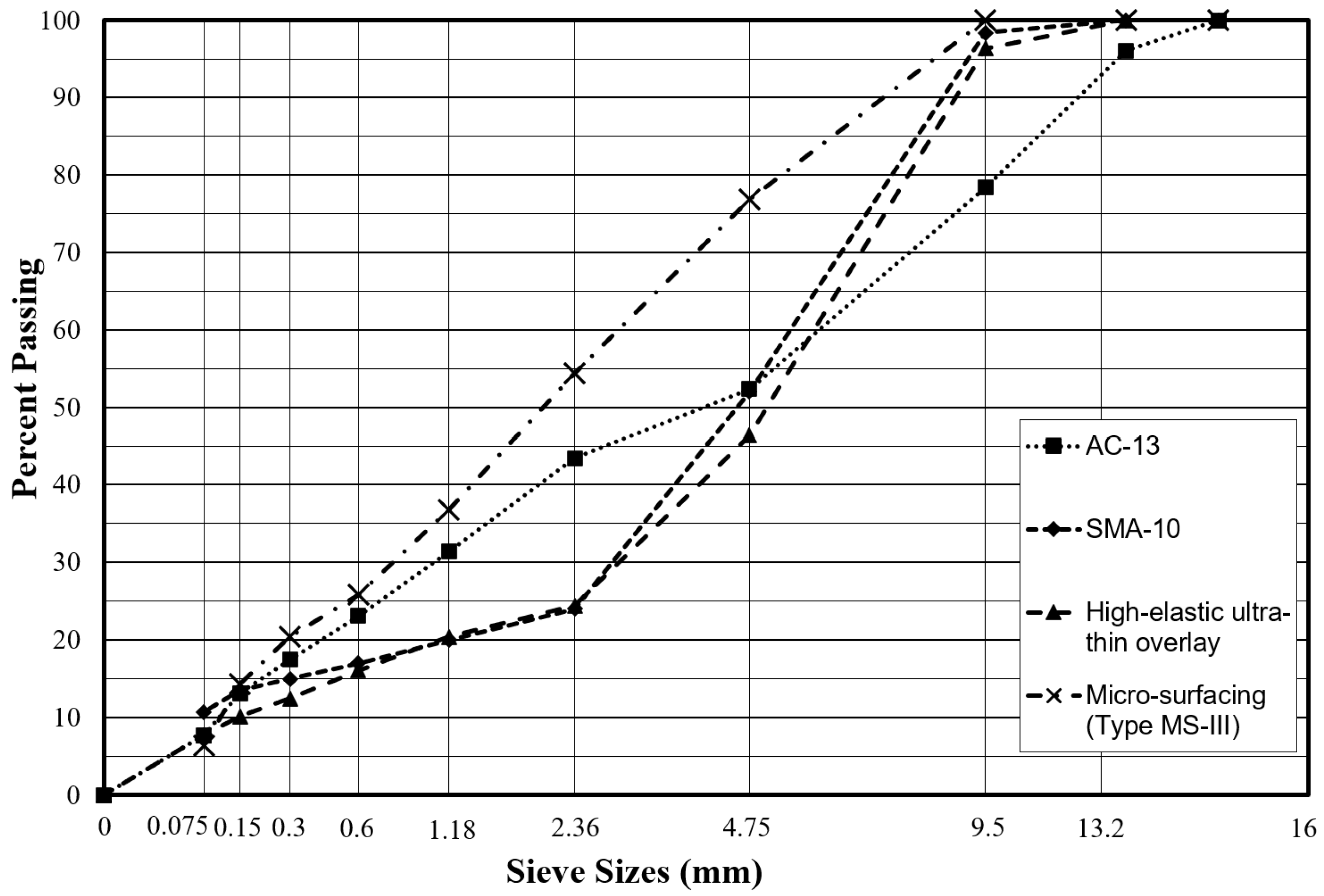
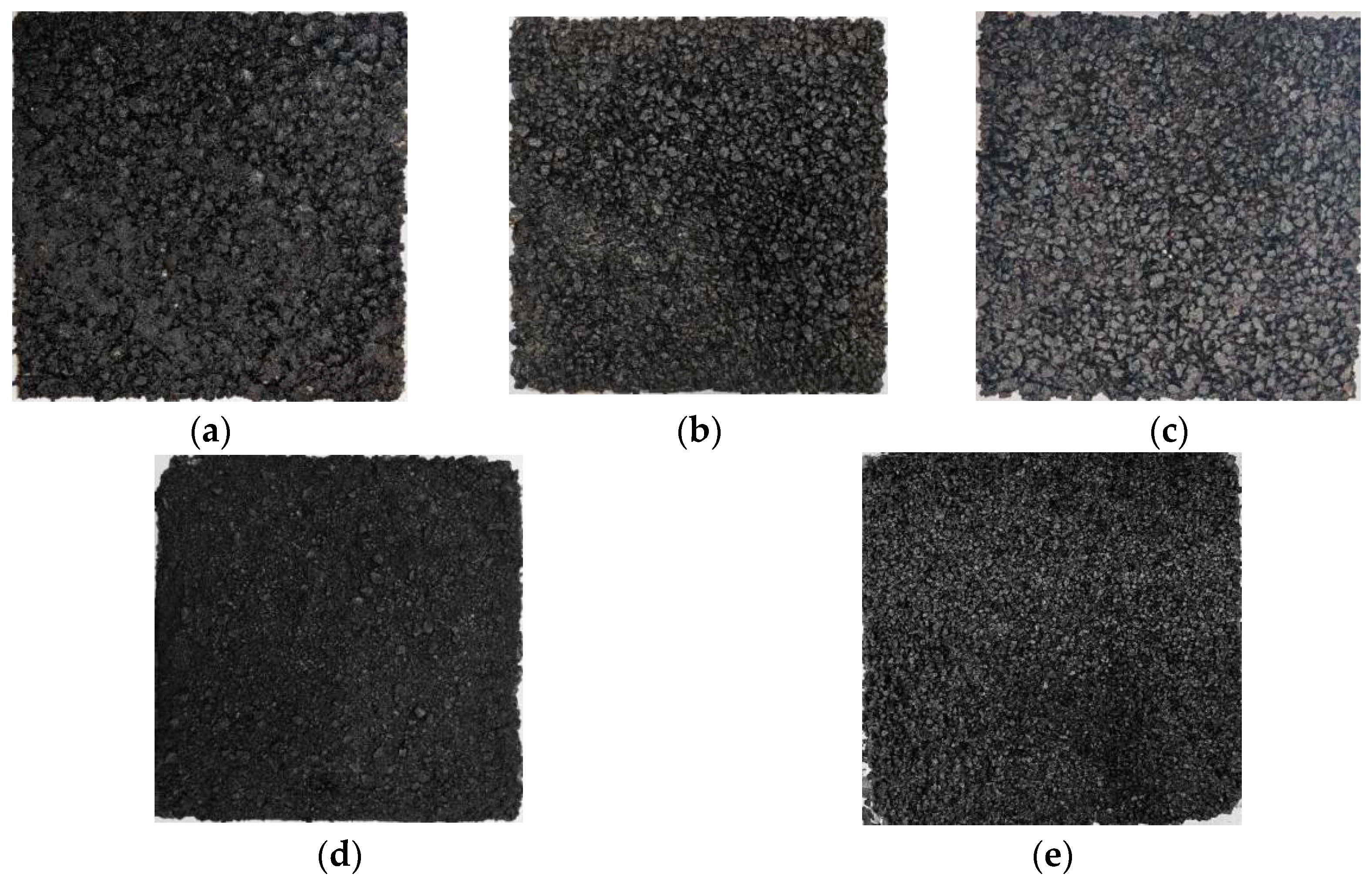
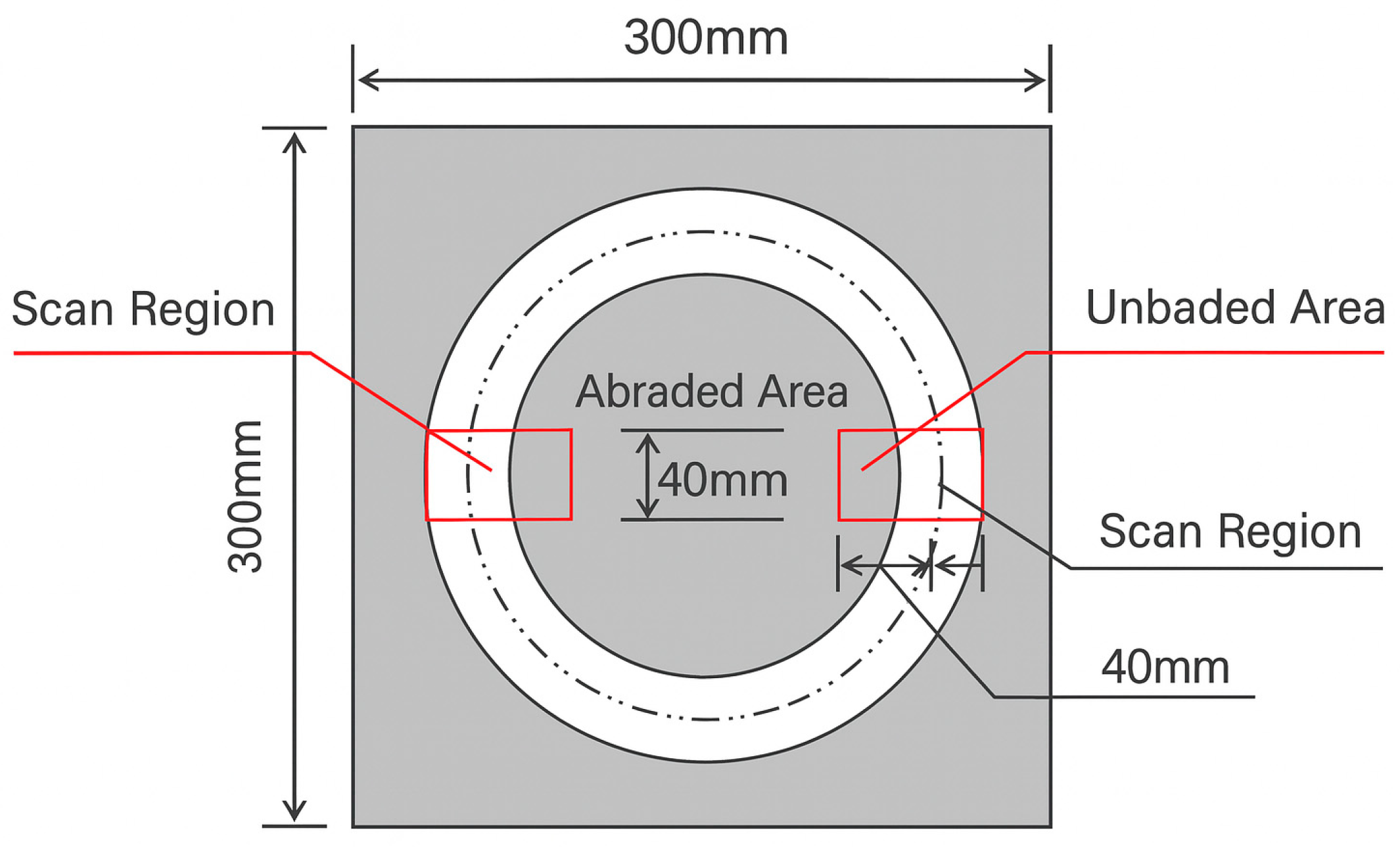
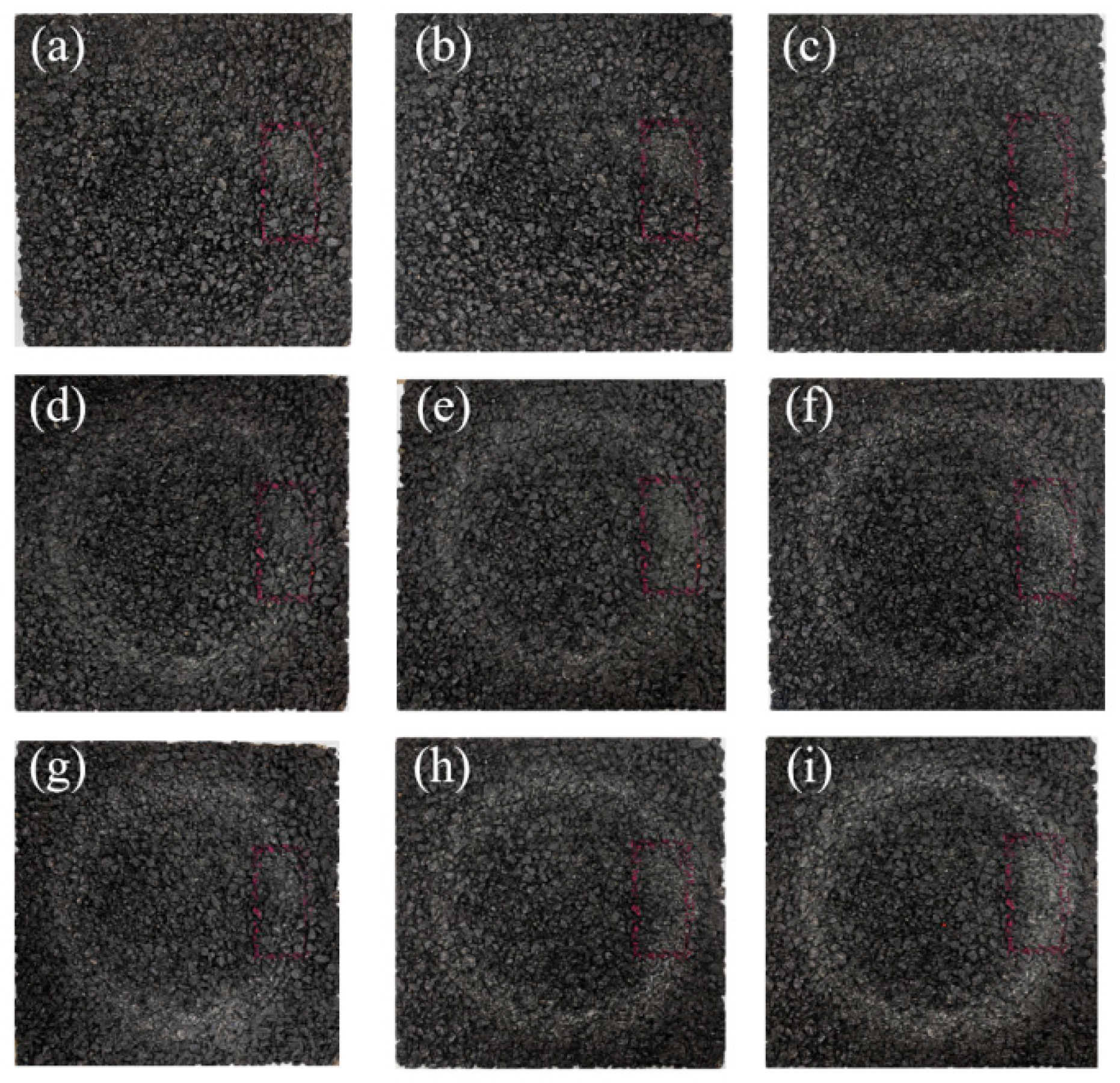

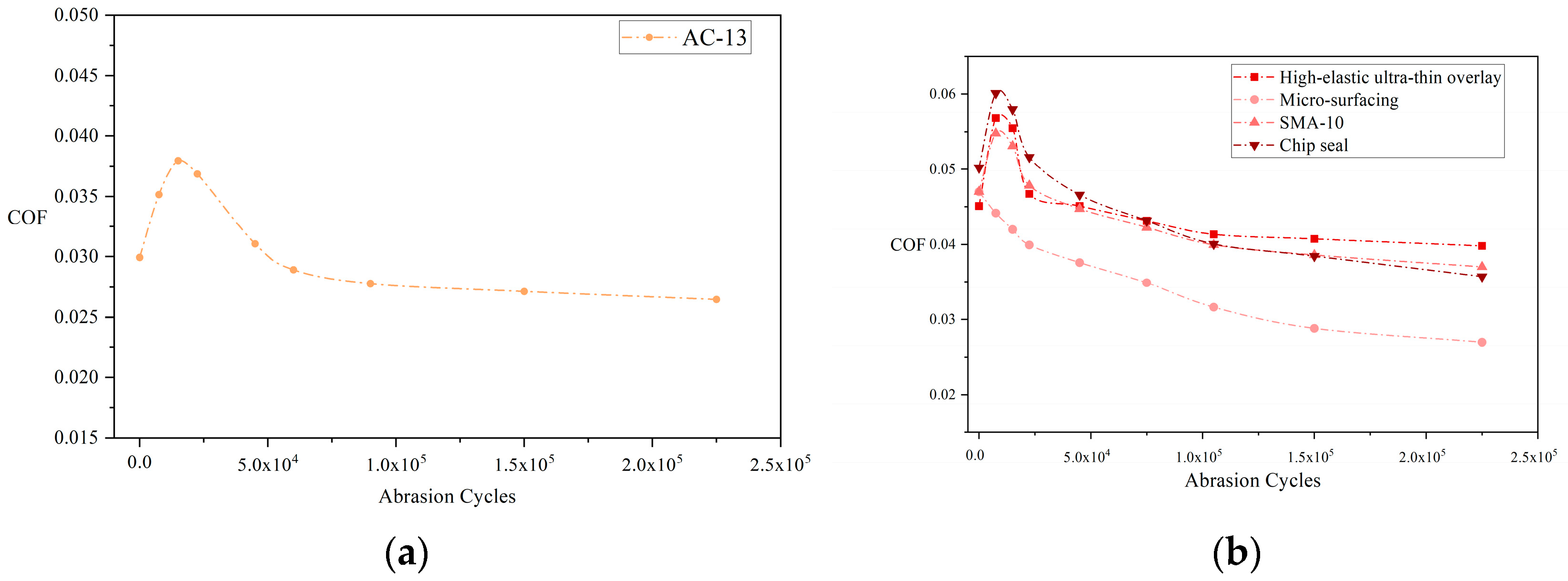

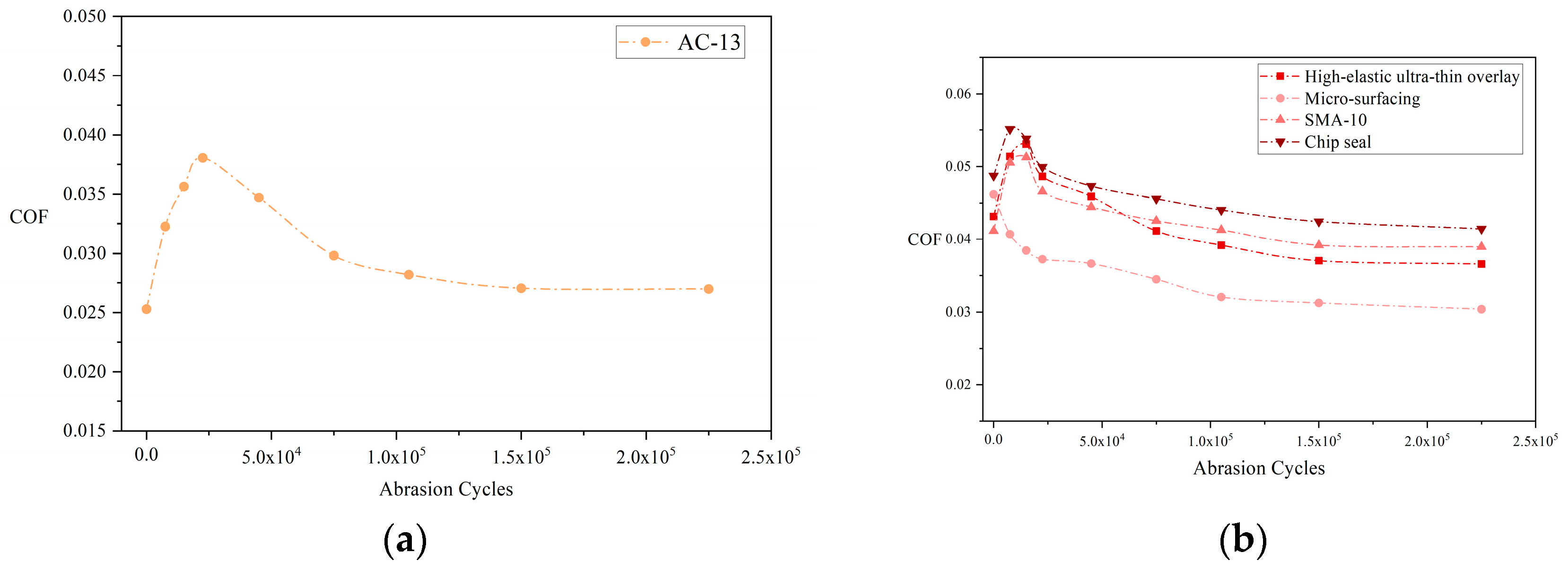
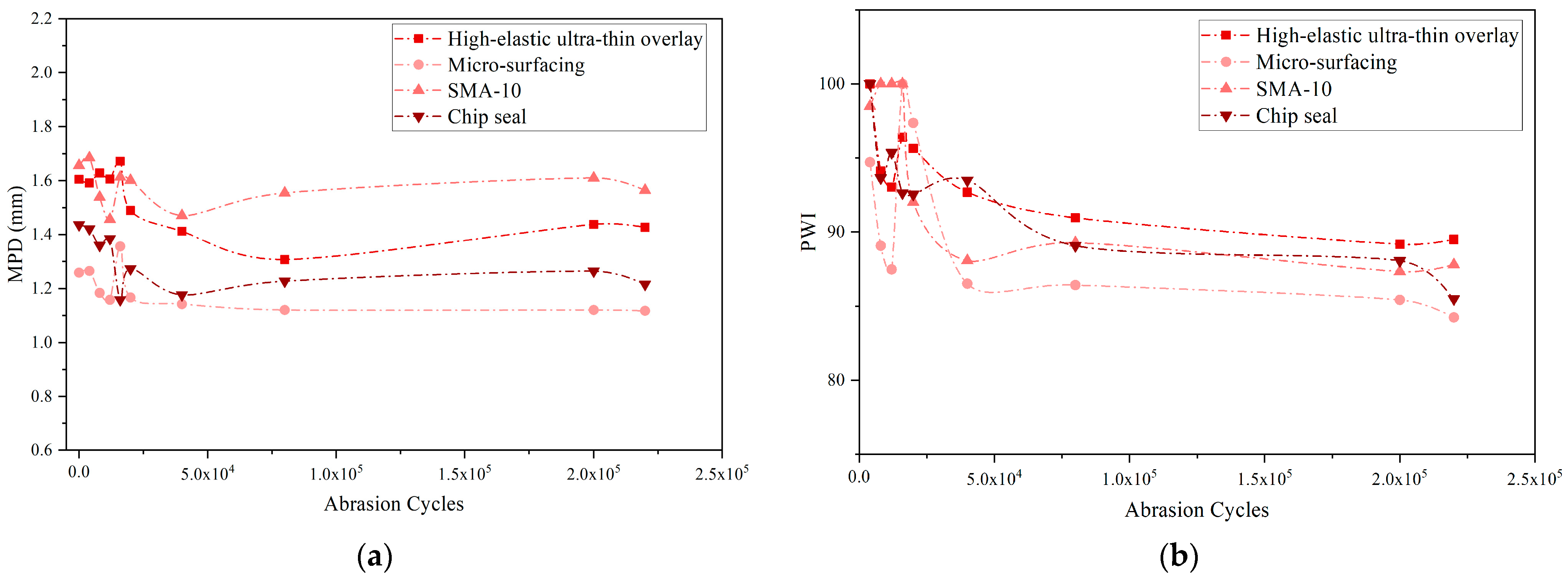
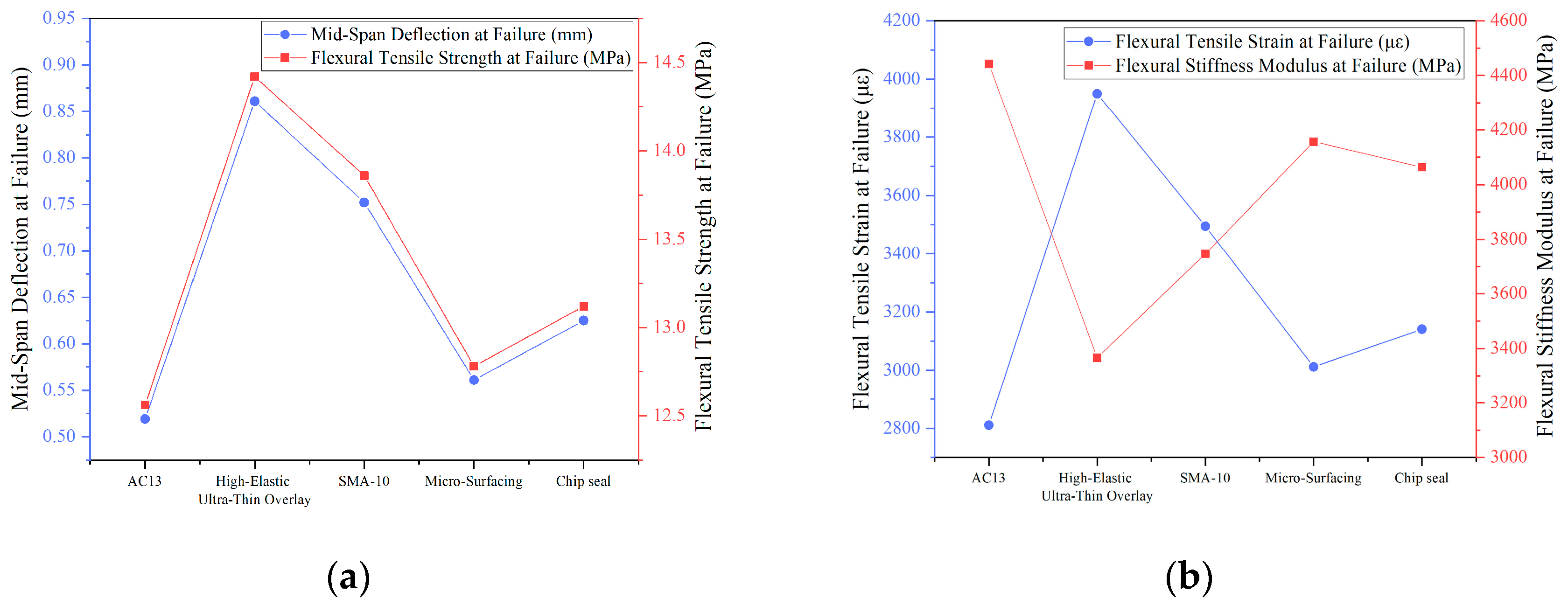
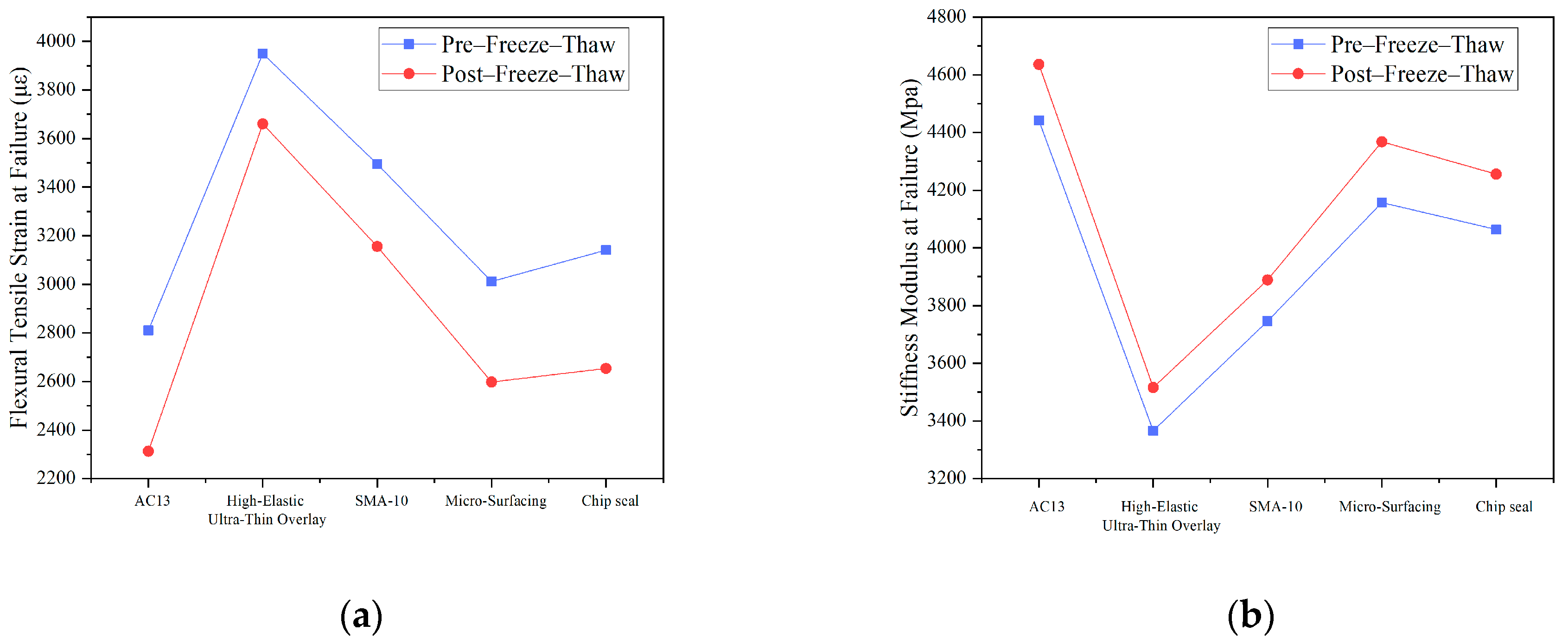
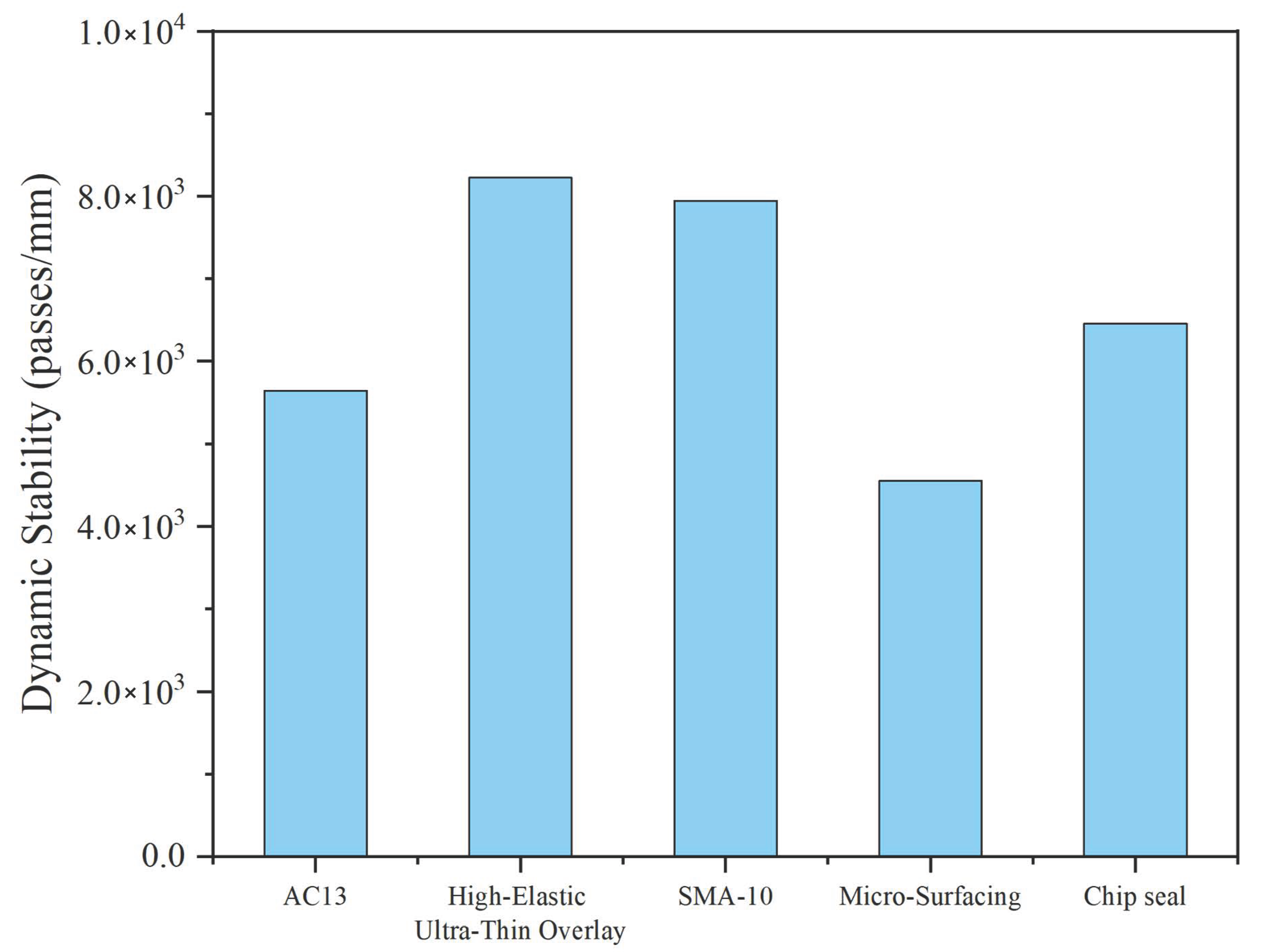
| Test Item | High-Elastic Ultra-Thin Overlay | MS-III Micro-Surfacing | Chip Seal | SMA-10 Thin Overlay | Test Result | Test Method |
|---|---|---|---|---|---|---|
| Crushing Value (%) | ≤26 | ≤26 | ≤26 | ≤25 | 10.6 | T 0316-2005 |
| Soundness Value (%) | ≤12 | ≤12 | ≤12 | ≤12 | 0.95 | T 0314-2000 |
| Bulk Specific Gravity (g/cm3) | ≥2.70 | ≥2.70 | ≥2.60 | ≥2.60 | 2.72 | T 0304-2005 |
| Los Angeles Abrasion Value (%) | ≤28 | ≤28 | ≤28 | ≤28 | 9.4 | T 0317-2005 |
| Polished Stone Value (PSV) | ≥42 | ≥42 | ≥42 | ≥42 | 51.4 | T 0321-2005 |
| Flakiness Index (%) | ≤12 | ≤15 | ≤5 | ≤10 | 3.2 | T 0312-2005 |
| Water Absorption (%) | ≤1 | - | - | ≤2 | 0.6 | T 0304-2005 |
Disclaimer/Publisher’s Note: The statements, opinions and data contained in all publications are solely those of the individual author(s) and contributor(s) and not of MDPI and/or the editor(s). MDPI and/or the editor(s) disclaim responsibility for any injury to people or property resulting from any ideas, methods, instructions or products referred to in the content. |
© 2025 by the authors. Licensee MDPI, Basel, Switzerland. This article is an open access article distributed under the terms and conditions of the Creative Commons Attribution (CC BY) license (https://creativecommons.org/licenses/by/4.0/).
Share and Cite
Kong, F.; Li, Y.; Wang, R.; Hu, X.; Yu, M.; Jin, D. Road Performance Evaluation of Preventive Maintenance Techniques for Asphalt Pavements. Lubricants 2025, 13, 410. https://doi.org/10.3390/lubricants13090410
Kong F, Li Y, Wang R, Hu X, Yu M, Jin D. Road Performance Evaluation of Preventive Maintenance Techniques for Asphalt Pavements. Lubricants. 2025; 13(9):410. https://doi.org/10.3390/lubricants13090410
Chicago/Turabian StyleKong, Fansheng, Yalong Li, Ruilin Wang, Xing Hu, Miao Yu, and Dongzhao Jin. 2025. "Road Performance Evaluation of Preventive Maintenance Techniques for Asphalt Pavements" Lubricants 13, no. 9: 410. https://doi.org/10.3390/lubricants13090410
APA StyleKong, F., Li, Y., Wang, R., Hu, X., Yu, M., & Jin, D. (2025). Road Performance Evaluation of Preventive Maintenance Techniques for Asphalt Pavements. Lubricants, 13(9), 410. https://doi.org/10.3390/lubricants13090410






